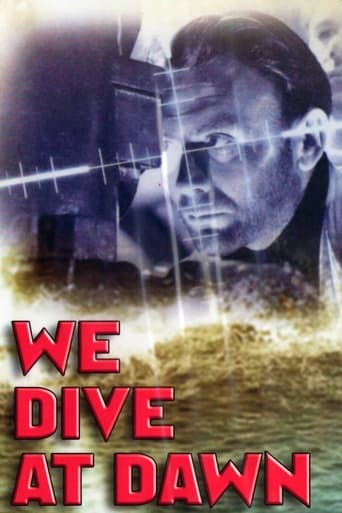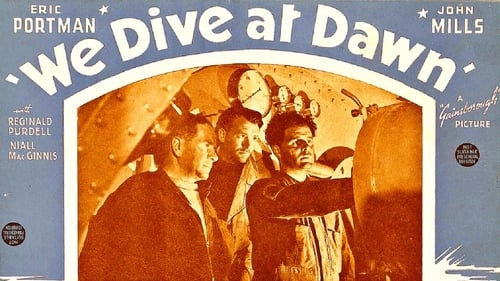Curapedi
I cannot think of one single thing that I would change about this film. The acting is incomparable, the directing deft, and the writing poignantly brilliant.
Donald Seymour
This is one of the best movies I’ve seen in a very long time. You have to go and see this on the big screen.
Ella-May O'Brien
Each character in this movie — down to the smallest one — is an individual rather than a type, prone to spontaneous changes of mood and sometimes amusing outbursts of pettiness or ill humor.
Guillelmina
The film's masterful storytelling did its job. The message was clear. No need to overdo.
JohnHowardReid
A Gainsborough Picture, made at Gaumont British Studios, Shepherd's Bush. Neither copyrighted nor theatrically released in the U.S.A. Released in the U.K. through General Film Distributors: 28 June 1943. Presented by J. Arthur Rank. London opening at the Odeon, Leicester Square: 20 May 1943. Australian release through 20th Century-Fox: 7 September 1944 (sic). 8,557 feet. 95 minutes. (NTSC available on a VCI DVD; PAL available on a Simply Media DVD or an ITV Silver Collection disc). SYNOPSIS: A British submarine receives orders to sink a Nazi battleship. NOTES: Made with the co-operation of the Admiralty and the officers and men of His Majesty's submarines. The Navy did not think the original Williams-Valentine script "sufficiently authentic", so Launder was engaged. He revised the script with the help of an experienced submarine officer.COMMENT: No greater contrast can be found than that between the war- time propaganda movies made by England and the USA. The Hollywood product is full of false heroics and exaggeratedly racist bravado ("One of us is worth ten of them"), glamorized action and an enormous amount of dame-chasing on leave. The British movies are soberly realistic to a fault (you actually go away from "We Dive At Dawn" with more than a passing knowledge of the interior workings of a submarine); little attempt is made to glamorize war and give it a glossy sheen of high adventure (although there is plenty of tension, war is usually shown in all its horror and futility and mindless waste); whilst the Germans are invariably presented as lacking the quick wits of the English, they are still a force to be taken extremely seriously; and leaves are usually spent quietly with families in environs far removed from high- stepping night clubs.On the other hand, both American and British war pictures usually devote a great deal of their screen time to filling in the characters of a select group of officers and men. Whilst the Hollywood writers often fall back on stereotypes and stock characters, their British counterparts are more successful in presenting a diverse and more interesting range of personnel. The English have never been afraid of eccentrics and non-conformists, whereas to an American scriptwriter, any character who doesn't conform simply has to redeem himself by some heroic act in the final reel. The British certainly believe in team spirit, but the Americans demand total subjection to predetermined rules of conduct."We Dive At Dawn" is an excellent example of the British school. Well-rounded, interesting characters are soberly, and realistically acted by a large group of fine players with whom we can sympathize and identify. A great deal of the action is fascinatingly concerned with the details of submarine command. And the film has been put together with admirable competence and professionalism but without overt flashiness or unrealistic special effects. Asmittedly, "We Dive at Dawn" takes a fair while to get cracking, what with all the boat-side camaraderie as the various characters are introduced. In these early sections of the film we feel too that the two star performances, Portman (top-billed, though his is the subsidiary role) and Mills are somewhat lacking in depth. In fact they both seem too brusque to be totally convincing. However, Mills and Portman do settle down and grow as the story progresses. And some of the other below-decks business, particularly the running gag with the Arabella tattoo, also becomes more enthralling and/or amusing. Of curse, once the action really starts, with its surprising semi- documentary insistence on all the details and actual mechanics of the attack, this movie achieves a realism, a verisimilitude, a naturalistic tautness and tension worthy of Asquith's best work. Even Jack Cox's drab, gray-toned lighting photography comes into its own. Topped by an all-action climax.
James Smith
After watching American Sniper and being so disappointed, I needed a
war film fix. I needed to watch a realistic war movie portraying real
characters and real challenges.To do so I had to watch a movie made over 70 years ago on a shoe string
budget during war time called We Dive At Dawn. Don't get me wrong - I
could have watched Generation Kill or Band of Brothers, but I decided
to go with a classic British war film. If only today's 'try to be directors' with their enormous budgets would
learn from these classics, movies like The Hurt Locker and American
Sniper may actually have been good.Next on my viewing list is The Cruel Sea.
pawebster
The main interest here is the period detail. Those who make films today set in the 1940s ought to have a look and listen - then they might not make some of the mistakes of language and tone that are so common. However, we have to face the fact that this film is a cheap flag waver. The first third drags as we go through some unconvincing stories about the home lives of the sailors, mostly done in the "chirpy working class" mode that the British entertainment industry favoured at the time. The main story is far-fetched and the Danish village is made of the cheapest painted cardboard. During the war it was obviously important not to scare the families on the home front too much, with the result that there is little real sense of danger on the sub and hardly any casualties. In contrast, think of "Das Boot" with everyone bathed in sweat, cooped up in claustrophobic conditions, breathing foul air and scared out of their wits. It's not like that here. Despite the food and fuel running out and depth charges going off all around, everyone is pretty much calmness personified. On a positive note, the Germans are real ones and speak correct German, which was good going for a wartime film.
Terrell-4
If you're in the middle of a ferocious war and it's still not clear that you're going to come out on top, among the things you'll be concerned with is to keep up the morale of the civilians...to demonstrate that our troops have the bravery, the resourcefulness and the dedication to overcome all the odds in a noble cause. And that's just what director Anthony Asquith provided the British with 1943's naval war film, We Dive at Dawn. After more than 60 years, it's not surprising that some of the movie is dated. It doesn't help that the class stereotypes which help define the enlisted men from the officers can be jarring. Here, as in so many other British war films, the men invariably have thick regional working class accents while the officers speak with an educated fluency that would place them at home in England's finest ruling-class establishments. In this movie, Freddie Taylor (John Mills), the captain of the submarine Sea Tiger, is clever, confident, resourceful, aggressive, in control, good with his men, humorous with his peers, quick to make a decision. And it helps that he's lucky. His men are jolly tars, for the most part, competent at their jobs and always ready with a joke when things get tense. Although we spend the first third of the movie getting to know these people while they're on leave, after that things get tense quickly. Taylor and his sub are ordered to destroy the Brandenburg, a new German battleship. They just miss the ship when it enters the Kiel Canal and heads into the Baltic. Taylor assesses the risks and decides the Sea Tiger will go after it, through mine fields, anti-sub nets and with a real risk of not having enough fuel to return to home base. After several tense situations, the confrontation takes place. The Sea Tiger lets loose six torpedoes but has to dive, not knowing if it had done its job. After a clever subterfuge, Taylor outfoxes a couple of German destroyers but then realizes there is not enough fuel. He plans to scuttle his sub and surrender when, just at the last moment, James Hobson (Eric Portman), a seaman who had been sullen and a loner and who speaks German, says there is a small Danish coastal village that had been a fuel depot. He thinks it might still be for the Germans. The last third of the movie is a rousing action sequence as the crew of the sub attempts to hold off the Germans long enough to pump in enough fuel to get the Sea Tiger back to Britain. This is a wartime propaganda movie, so don't expect failure. And did the Sea Tiger actually put the Brandenburg down? Are the men reunited with their wives and sweethearts? Did Hobson have a reconciliation with his wife and small son that left him smiling for once? Did Freddie Taylor finally have a chance to make use of all those female names in his little black book? You'll have to see the movie. There are propaganda war movies and there are propaganda war movies. Some, like Powell's and Pressburger's One of Our Aircraft Is Missing and The 49th Parallel, still stand up to viewing today because the stories are solid and unexpected and the creators didn't use obvious shorthand clichés. Others, like We Dive at Dawn, were made with enough clichés that when watching we have to remind ourselves how dire the time was when the film was made. Still, Asquith can build a lot of suspense even with a few clichés. The Sea Tiger's forcing its way through a sub net was tense. The stalking of the Brandenburg and the plotting needed for the torpedo firing was realistic; John Mill's no-nonsense attitude while he prepared to attack was well-handled. The fake-out preparations to make the Sea Tiger look as if it had been destroyed by depth charges was as realistic, inside the sub as well as out, as you could hope for, and the battle for the fuel depot was dramatic and exciting. We Dive at Dawn is not a classic war film, but it's a well-made, well-acted example of its type and time. John Mills, it's worth noting, had a long, long career. Especially in the Fifties he played in a number of serious-minded films looking back at those WWII days. He had the quality of showing grit, cheerfulness and perseverance, but of also being trustworthy, a man England could be proud of as he fought the war. Top-billed in this movie was Eric Portman, a fine actor with a unique voice and the ability to give stares so cold you'd want to put on a sweater. Everyone on the sub is very much in the joking but stiff-upper-lip mode, but Portman manages some complexity for his character. Mills and Portman did fine jobs working together on this film.


